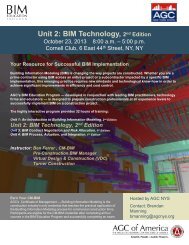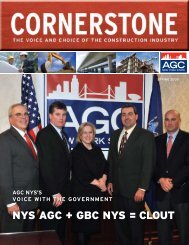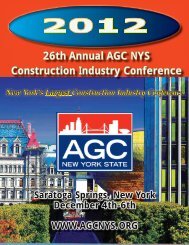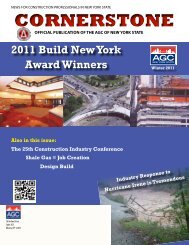Construction
Winter 2012 - The Associated General Contractors of New York ...
Winter 2012 - The Associated General Contractors of New York ...
- No tags were found...
Create successful ePaper yourself
Turn your PDF publications into a flip-book with our unique Google optimized e-Paper software.
Award Winner: Lake Champlain Bridge<br />
Team Members<br />
Prime <strong>Construction</strong>: Flatiron <strong>Construction</strong><br />
Owner: New York State Department of Transportation<br />
Project Engineer: HNTB<br />
AGC NYS CORNERSTONE WINTER 2012<br />
The new 2,200-foot-long Lake Champlain Bridge in northern New York State for owner New York State<br />
Department of Transportation set a new industry standard for expedited construction. The two-lane steel arch<br />
span structure across Lake Champlain, which replaces a structurally deficient two-lane bridge demolished<br />
in December 2009, was constructed in less than 18 months. The bridge, which connects Essex County, N.Y. and<br />
Addison County, Vt., was designed by HNTB and built by Flatiron under a bid-build contract.<br />
The new bridge, with a signature network tied arch design, both preserves the historic integrity and aesthetic<br />
quality of the original bridge, while incorporating features that will contribute to a 75- to 100-year design life. The<br />
bridge’s main span is comprised of a basket handle modified network steel tied-arch 402-feet-long and 80-feet-tall<br />
supported on delta fixed frames. The arch provides a 75-foot navigational clearance and 300-foot-wide channel<br />
below. It has a basket handle arch with a network cable arrangement and internally redundant box tie girders<br />
supporting a composite precast deck system. The new bridge has wider lanes to accommodate farm equipment, as<br />
well as sidewalks for pedestrians and wide shoulders for cyclists. The project also included construction of 1,029-<br />
foot approach on the New York side and a 769-foot approach on the Vermont side and demolition of temporary<br />
causeways and ferry docks.<br />
A main feature of the new bridge is the zinc metalized corrosion protection applied to the structural steel. It is one<br />
of the largest bridges in North America to be completely zinc metalized. The pier footings are faced with granite<br />
to protect the concrete substructures from ice damage. Additionally, the redundant design more easily allows for<br />
maintenance and repairs.<br />
The bridge’s entire main span structure was built on land at an off-site location. In an operation beginning before<br />
dawn and lasting well into the night, Flatiron crews floated the Lake Champlain Bridge’s 900-ton central arch across<br />
the lake and hoisted it nearly 80 vertical feet. The arch was joined to the approaches from the New York and<br />
Vermont sides using strand jacks at each corner.<br />
The bridge closure was a major hardship to the communities on both sides of Lake Champlain. For two years, the<br />
nearly 3,400 daily travelers between Essex County, N.Y. and Addison County, Vt. relied either on a 100 mile detour<br />
around the lake or a ferry system initiated after the old bridge structure was closed. Commutes that once took<br />
40 minutes were increased to as much as two hours when the old bridge closed. The bridge provided a critical<br />
connection between the two regions, which are economically linked and share services, including hospitals and first<br />
responders.<br />
Impact to the local community was the driving factor for the aggressive 18-month completion schedule. When the<br />
original 1929 bridge was found to be in danger of imminent collapse and closed, initial estimates put completion<br />
of a new bridge several years away. In addition, harsh New England weather challenged the accelerated schedule<br />
further. In May 2011 crews watched helplessly as the water level at Lake Champlain rose to 103 feet-six inches<br />
higher than the previous record, set a century ago. The storms flooded the assembly yard, where the arch was ready<br />
to assemble, for three weeks.<br />
Even with the weather setbacks, the team’s accelerated project delivery resulted in the bridge opening to traffic in just<br />
18 months - a dramatically shorter time frame than anticipated. Motorists now enjoy delay-free crossings once again.<br />
The new bridge serves not only as a replacement to the old bridge, but also represents a significant improvement<br />
to the region’s infrastructure, assisting in re-building the region’s economy through a safe and innovative structure.<br />
36







